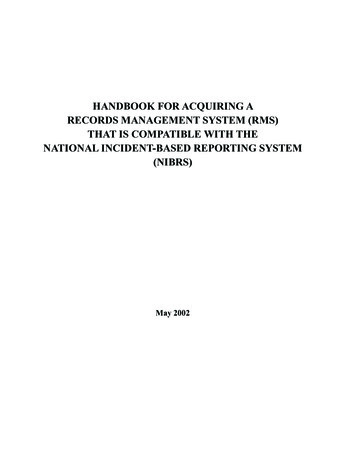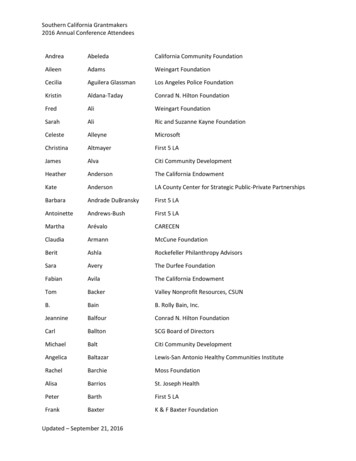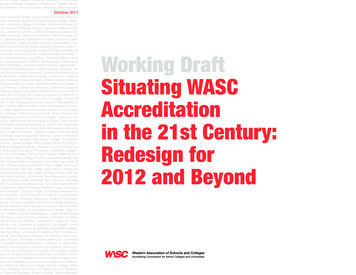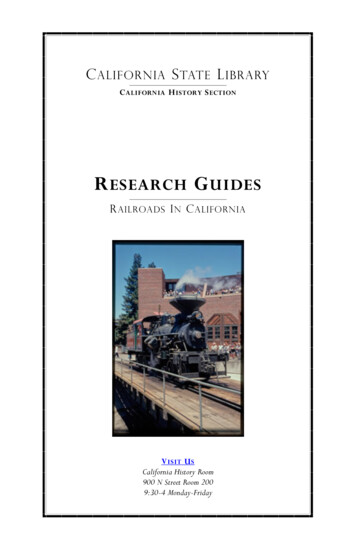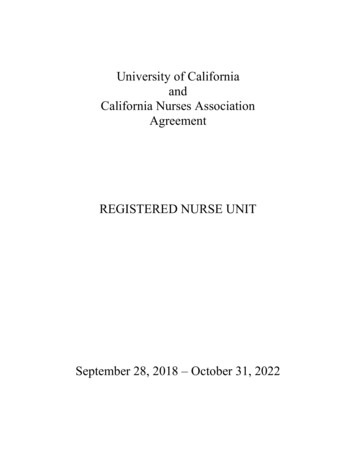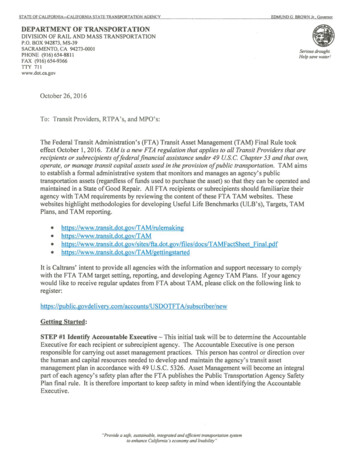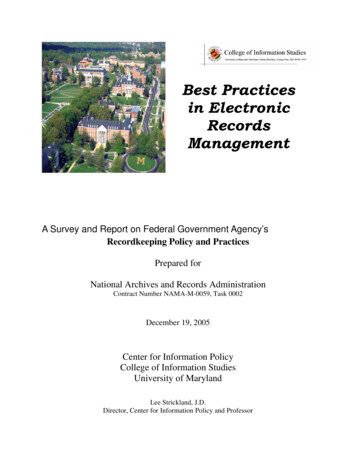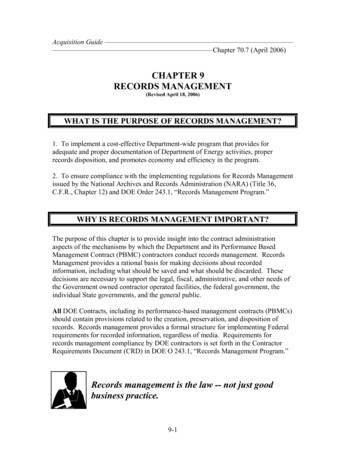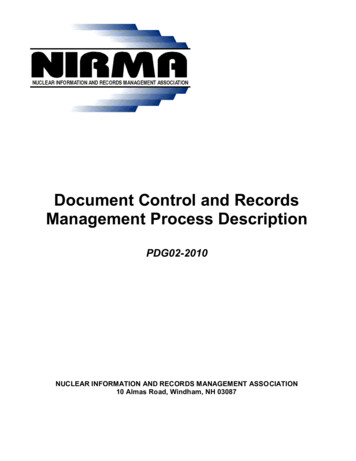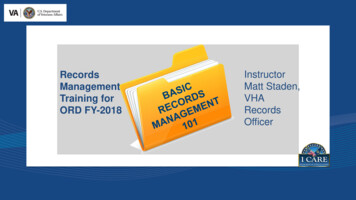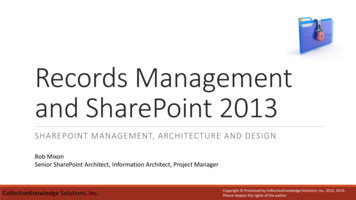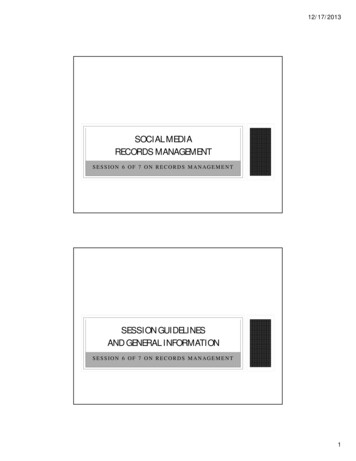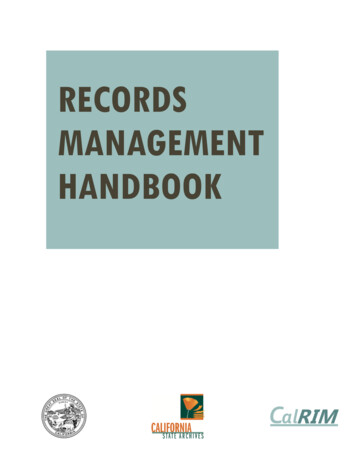
Transcription
RECORDSMANAGEMENTHANDBOOK
TABLE OF CONTENTSCHAPTER 1 – INTRODUCTION1What is Records Management?1What is a Record?4What is Not a Record?5Record vs. Record Series5The Life of a Record7The Purpose of a Records Management Program9CHAPTER 2 – ESTABLISHING THE PROGRAM10Role of the Records Management Coordinator (RMC)11Role of the Records Management Assistant Coordinator (RMAC)13CHAPTER 3 – RECORDS INVENTORY16The Records Inventory16Preparing for the Inventory17Records Inventory Roles and Responsibilities19Creating a Map19Desk by Desk21Records Inventory Worksheet (STD. 70)22Record Series Title22Record Series Description23File Location23Media Type24Years Covered25Reference Status25Document26Volume26Remarks27Completing the Inventory27Table of ContentsII
CHAPTER 3 – RECORDS INVENTORYWhy Conduct Regular Inventories?28CHAPTER 4 – RECORDS APPRAISAL30What is Records Appraisal?30Why Appraise Records?30Appraisal Categories31Administrative Value of Records32Legal Value of Records32Fiscal Value of Records33Research & Historical Value of Records33Vital Records34The 3-2-1 Rule35The Importance of Managing Vital Records35Information Classification36CHAPTER 5 – RECORDS RETENTION SCHEDULE37What is a Records Retention Schedule?37What is the Purpose of a Records Retention Schedule?38The Records Retention Schedule Process40CHAPTER 6 – APPROVAL OF RECORDS RETENTIONSCHEDULES42CalRIM Approves the Retention Schedule42Approval Procedure42Submitting the Schedule for Review42Submitting an Organizational Chart43Mailing the Final Paper Copy to CalRIM43Approval Number Assigned44Approval Date Assigned and Expiration Date Set44SRAP Approval44Table of ContentsIII
CHAPTER 6 – APPROVAL OF RECORDS RETENTIONSCHEDULESThe Life of a Records Retention Schedule46CHAPTER 7 – IMPLEMENTING RECORDS RETENTIONSCHEDULES47Implementing Schedules47First Steps48Ongoing Efforts49Destroying Records50Establishing Policies and Procedures50Information Governance51Records Management Implementation Checklist52CHAPTER 8 – AMENDMENTS & REVISIONS53Maintaining Records Retention Schedules53Amending Records Retention Schedules54Revising Records Retention Schedules55Summary of Changes56CHAPTER 9 – EXTERNAL STORAGE FOR RECORDS57When to Store Records Outside the Office57Requirements for External Storage57The State Records Center (SRC)58Ordering Records Storage Boxes59Packing Records Storage Boxes60Transferring Records to the SRC61CHAPTER 10 – DISPOSITION OF RECORDS62In-House Destruction63SRC Record Destruction64Transferring Records to California State Archives64Table of ContentsIV
CHAPTER 10 – DISPOSITION OF RECORDSPreparing Records for Transfer to the State Archives65Records at Risk66CHAPTER 11 – CONCLUSIONS68Reasons for Having a Records Management Program68It’s the Law68Save Space, Time, and Money68Avoid Litigation69Improving Workflow70Table of ContentsV
STATE OF CALIFORNIARecords Management HandbookRECORDS RETENTIONThe records management program section (Chapter 1600) of the State AdministrativeManual (SAM) defines the responsibility of each agency to implement a recordsmanagement program and prescribes the procedure for scheduling and disposing ofrecords. This Records Management Handbook supplements the information in SAMand the practical guidelines posted on the California Records and InformationProgram’s (CalRIM) website.Prepared by:Secretary of State, Archives DivisionCalifornia Records and Information Management Program (CalRIM)State Records Appraisal Program (SRAP)Authors:Jeff Crawford, Ramona Gutierrez-Scholz, Andrew Hyslop, Tamara Martin, MichaelMcNeil, Tierney R. O’Donnell, Dennis SupachanaOriginal Publication Date: April 29, 2008Updated: December 2018Chapter 1 – IntroductionPage 1 of 70
CHAPTER 1IntroductionOur ability to manage records has not kept pace with ourability to create them. We have computers full of files andfolders and images; inboxes brimming with emails; highspeed copiers grinding out reams of paper; cloud serversstoring terabytes of data; filing cabinets and store roomsand binders and desk drawers stuffed with documents.While paper records are still the backbone of many offices’ workflow, electronic recordsare emerging as the future of records management. In today’s highly technicalenvironment, the majority of our records are created and maintained electronically. Wewill analyze this further and delve into the maintenance of electronic records in thishandbook.How Does Your Records Management Program Look? Do you know what records you have and where they are located? Who uses those records and how often? How much does it cost to store your records? Who oversees your records management program? Does your agency have Retention Schedules for all its records? Can you rely on your Schedule when you receive a Public Record Act (PRA)request?What is Records Management?Records Management is the system an office uses to create, maintain, and preserve ordestroy its records. When a State entity creates a record, a plan must exist for wherethe record will be kept, how long it should be kept, will it need to be preserved forhistorical reasons, or will it eventually be destroyed?Chapter 1 – IntroductionPage 2 of 70
Note:There are many different types ofentities in California that createState records—Agencies, Boards,Bureaus, Departments, etc. Forsimplification, this Handbook willuse the phrase “State entity” toencompass all these groups.The Secretary of State has assigned thedevelopment and implementation of the state’srecords management program to the CaliforniaRecords and Information Management (CalRIM)program and the State Records AppraisalProgram (SRAP) within the State ArchivesDivision.1 The programs were established to“administer a records management program [forthe State] which will apply efficient andeconomical management methods to the creation, utilization, maintenance, retention,preservation and disposal of state records”.2State entities are required to comply with the rules, regulations, standards, andprocedures related to records management issued by the Secretary of State through theCalRIM and SRAP programs.3CalRIM operates based on several Government Codes which outline how governmentrecords should be dealt with:Statutory Authorities: Public Records Protection and Recovery (Government Code §§6204-6204.4) State Archives (Government Code §§12220-12237) State Records Management Act (Government Code §§12270-12279) State Records Storage Act (Government Code §14740-14746)1State Administrative Manual Section 1602Government Code §12272(a)3 Government Code §12274(d)2Chapter 1 – IntroductionPage 3 of 70
What is a Record?California Government Code defines records as “anywriting containing information relating to the conductof the public’s business prepared, owned, used, orretained by any state or local agency regardless ofphysical form or characteristics.”4A record is any document received, created, or used by a State entity during the courseof business. A record could be official correspondence, litigation files, video recordings,meeting minutes, social media, databases, maps, photographs, invoices, employeepersonnel files, and much more.Certain records like correspondence, meetingminutes, and employee personnel files are universallyused by almost all State entities. Each State entitymay also have more specialized records dependingon its duties and mission. For example, theDepartment of Finance will likely have more fiscalrelated records than other State entities; theDepartment of Human Resources will likely have morepersonnel-related records, etc.It is the responsibility of each State entity to develop a records management programtailored to the work the State entity performs and which suits the entity’s needs. CalRIMwill assist by providing training, holding informational meetings, and by reviewing andapproving Records Retention Schedules.4California Government Code Section 6252(e)Chapter 1 – IntroductionPage 4 of 70
What is Not a Record?While there are many different types of records, there are also many documents createdby State entities which may not be considered records. Copies, duplicates, orpublications that are kept for purposes of personal reference or convenience may not beconsidered records.Examples of Possible Non-Records: Personal papers or papers of a nonofficial nature that pertain to an individual’sprivate affairs. Informal notes, worksheets, and rough drafts that do not represent the basicsteps taken to prepare the document. Library and reference material. Material used to facilitate operations but not to support, enable, or documentadministrative action.Record vs. Record SeriesWhile a record is any document created by a State entity during the course of business,a record series is a group of related records arranged under a single major category.These records are created and maintained as a unit because of their relationship andthe purpose they serve.RecordSeriesRecordRecordRecordFigure 1. Individual Records Comprising a Record SeriesChapter 1 – IntroductionPage 5 of 70
The records may deal with a particular subject, may result from the same activity, ormay have a distinctive form—such as maps, blueprints, and purchase requests, etc. Arecord series may exist in any format or possibly exist in multiple formats—electronic,magnetic, microfilm, paper.Record series become very important when taking an inventory of records. During theinventory, a list will be created of records kept in the office—in drawers, filing cabinets,on computers or cloud storage, etc. All the records kept in the office will then becombined into records series and added to the Records Retention Schedule.Each record series must have a title. The title should be concise and descriptive of thetypes of records contained in that series. For example, the title “Project X Files” refersto records that pertain to a particular project being completed by the office.Project XFilesConsultantReportsBudgetReportsMedia ActivityFigure 2. Example of Records Within a Record SeriesThis is just one possible example of how to organize a record series. Depending on theneeds of the State entity, records series may be organized in many different ways. Forexample, the Project X Budget Reports may be listed under the Fiscal Records seriesand the Project X Media Activity may be listed under the Media Records series.FiscalRecordsProject roller'sDocumentsFigure 3. Fiscal Record Series Example StructureChapter 1 – IntroductionProject XMediaActivityFacebookPosts &CommentsNews ClipsFigure 4. Media Record Series Example StructurePage 6 of 70
The structure of records series should reflect current business practices. Recordsshould be organized into series based upon how they are used during daily businessand how they are organized within the office. How to enter these records and recordsseries in the inventory and in the Records Retention Schedule will be covered later inthis Handbook.The Life of a RecordRecords are dynamic, not static. Very few records are important enough to be keptforever. The original California Constitution is preserved in the State Archives forposterity. Regular office files may only need to be retained for a certain period of years,then destroyed.Storage vs. ArchivalStorage may refer to records being retained somewhere other than the office wherethey are created, used, or received. This may include a storage facility within thebuilding, the State Records Center (SRC) or some other storage facility, or cloudstorage. When a record is “archived” it is sent to the State Archives to beaccessioned, evaluated, preserved, and referenced.Even long-lived records have a creation date, a period of usefulness, and a disposition.A record’s creation and its disposition (destruction or transferal to the State Archives)are the beginning and ending of its life.Chapter 1 – IntroductionPage 7 of 70
Record isCreated/ReceivedRecord isDestroyedRecord isUsedRecord isStoredRecord isSent toArchivesFigure 5. Life of a RecordFive general steps most records go through during their life:1) Creation: When information and records are created or received.2) Use: When information and records are transmitted to those who need them and,upon receipt, are used in the conduct of business.3) Storage: When information and records are filed or stored to permit subsequentretrieval and are protected so as to safeguard the integrity of the information.Stored records should be regularly appraised to determine their reference statusand value. If the record is not frequently referred to, it may be stored in anotherlocation away from the office.4) Destruction: When information and records reach the end of their retention andhave no further legal, fiscal, or administrative value they are safely destroyed OR5) Archival: When information and records are preserved in the State Archives foron-going historical reference or research purposes. A record’s archival value isdetermined by the State Archives, not by State entities.5 Once the record istransferred to the State Archives, it no longer belongs to the State entity.In order to have a robust records management program, it is important to take amacroscopic view of the life of the records a State entity holds. By examining howrecords are created, who uses them, where they are stored, and how often they need tobe referenced, State entities will be able to make informed decisions regarding the use,storage, and disposition of their records. There may be more efficient ways to store5Government Code §12224Chapter 1 – IntroductionPage 8 of 70
records. Some of the records may not be referenced very often and may be storedoffsite in a less expensive facility. State entities may be able to dispose of records thatare no longer useful to business operations. Space, time, and money may be saved bylooking at the life of records and building a records management program according tothat life process.The Purpose of a Records Management ProgramProperly managed, records protect personal and organizational rights, as well assupporting, defending, and accounting for the State’s business activities. A recordsmanagement program ensures that information contained in the State’s records isavailable to the public when and where it is needed at the least possible cost. Stateentities are mandated by the State Records Management Act6 to establish “andmaintain an active, continuing program for the economical and efficient management ofthe records and information collection practices of the agency.”6Government Code §12270-12279Chapter 1 – IntroductionPage 9 of 70
CHAPTER 2Establishing the ProgramFor a records management program to besuccessful, support must come from the top down.Top level management must be aware of theTop LevelManagementMid LevelManagementprogram’s goals and the importance of achievingthose goals. Records management policiescannot be enforced agency-wide without executivesupport. Middle level management must also beRecordsManagementFigure 1. Management Participation in aRecords Management Programonboard. Their staff will be on the records management team working with the recordson a daily basis. One way to keep top and middle level management engaged is toinvite them to attend California Records and Information (CalRIM) training classes andevents.Once management support for the program has been obtained, a highly motivated andknowledgeable facilitator must be assigned the role of Records ManagementCoordinator (RMC) for the agency.1 Responsibility for this function must be assigned ata level within the organization that has access to program managers and seniormanagement officials.SAM Recommendation:The State Administrative Manual (SAM) recommends that, “the Records ManagementCoordinator be assigned to staff at an SSA level or above.” This is because “acoordinator at the SSA level or above will have broader knowledge of the overall agencyorganization and function and be able to make management-driven recordsmanagement decisions.”212State Administrative Manual Section 1604State Administrative Manual Section 1604Chapter 2 – Establishing the ProgramPage 10 of 70
Role of the Records Management Coordinator (RMC)The RMC is in charge of the entire records management program for their State entity.They serve as the contact person for all records management-related issues both withinand outside the State entity. The RMC serves as the liaison between their State entityand the Secretary of State’s (SOS) CalRIM program and State Records AppraisalProgram (SRAP). The RMC also serves as the liaison between their State entity andthe Department of General Services (DGS) and State Records Center (SRC).SOS CalRIM SRAPRMCDGS SRCFigure 2. Records Management Coordinator liaison roleThe RMC shall be appointed in writing by the Chief Administrative Officer of the Stateentity using the Records Management Team Designation Form. Once the RMC isappointed, the designation form must be filled out electronically and emailed toCalRIM@sos.ca.gov. The RMC will then be designated to contact CalRIM withquestions regarding Records Retention Schedules, transferring records to the SRC,confidential destruction of records, and any other records management-relatedquestions.The new RMC must also contact the SRC at (916) 375-6760 to let DGS know they arethe RMC for their State entity. The SRC may need to contact the RMC regarding thetransfer of records, the retrieval of records, record destruction, and more.Chapter 2 – Establishing the ProgramPage 11 of 70
Don’t Forget!Once an RMC is appointed, they must contact CalRIM at CalRIM@sos.ca.gov to let theRecords Management Analysts know they have been added to their State entity’srecords management team. RMCs must also contact the SRC at (916) 375-6760 andlet DGS know they have been appointed.Possible duties of the RMC may include: Coordinating the State entity’s records managementprogram. Conducting research into records retentionDUTIESrequirements. Reviewing and signing Records Retention Schedulesprior to submission to CalRIM. Tracking and maintaining Records Retention Schedulesto ensure current approval status. Reviewing and approving purchase or rental of filing equipment and shredders toprevent unauthorized destruction of records. Responsibility for reports, written justifications, requests for offsite storageapproval, or any other Retention Schedule documentation requested by CalRIMand/or SRAP. Regular disposition of records not stored atthe SRC. This includes transfer of records to theState Archives or the SRC, as well as destructionof records at the Document Destruction Center(DDC). Ensuring records are retained anddisposed of according to the Records Retention Schedule. Disseminating announcements of records management activities, policies, andprocedures. Scheduling appropriate training of records management personnel.Chapter 2 – Establishing the ProgramPage 12 of 70
Attending CalRIM Records ManagementCoordinators Semi-Annual meetings andsponsored technology forums. Periodically reviewing policies and procedures toensure that the program is properly applied.Being a Records Management Coordinator (RMC) is an important role. The RMC mustensure their State entity is abiding by records management rules and laws in order toprotect the State entity’s information assets, historical records, and to guard againstpossible litigation and audits. The role of RMC entails a great deal of power andresponsibility. The staff of CalRIM, SRAP, and the SRC are here to help with theseresponsibilities and to help RMCs create a well-run records management program.Role of the Records Management Assistant Coordinator (RMAC)The ongoing maintenance of a records management program may warrant the need foradditional assistance. If necessary, the RMC may need to assign the role of RecordsManagement Assistant Coordinator (RMAC) to one or several employees to assist themwith running the record
Role of the Records Management Coordinator (RMC) 11 . For example, the title “Project X Files” refers to records that pertain to a particular project being completed by the of
